Model village: a micro-town in Madrid masterplanned by Marcio Kogan’s studio
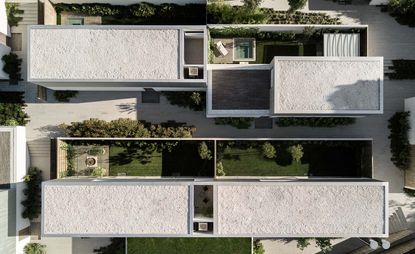
Studio MK27’s new housing scheme in Spain is substantial enough to pass for a lifetime’s architectural output for a less fortunate firm. Set in the western Madrid suburb of Somosaguas, the project covers more than a third of a hectare and comprises 21 private houses, arranged as a series of interlocking public and private spaces.
Marcio Kogan and Suzana Glogowski of Studio MK27 in São Paulo worked closely with the developer, builder and co-architect of the project, Enrique López of local operation Caledonian. For the Brazilians, the project was a first. ‘We’d retro-fitted interiors in Spain and Portugal, but this was our first new build in Europe,’ explains director Mariana Simas.
The job had its origins in Spain’s serious financial depression at the tail-end of the Noughties. ‘The client liked our projects,’ Kogan recalls, ‘and one day he called to say that he had an entire block near Madrid that he wanted to develop. Yet he also chose us for a particular economic reason. “In Brazil, you have a lot of experience of designing against crisis,” he told me.
That’s what he wanted to do in Spain. Design against crisis.’ The studio’s first proposal wasn’t met with much enthusiasm, though. ‘We suggested purchasers buy 70 sq m spaces, and then add another 70 to 150 sq m at a later date,’ recalls project architect Glogowski. ‘He refused that instantly,’ Kogan says cheerfully, ‘asking, “How can I sell something that doesn’t exist?”’ ‘We tried another approach,’ Glogowski continues, creating ‘a community that would be like an old medieval city – a pueblo – without cars’.
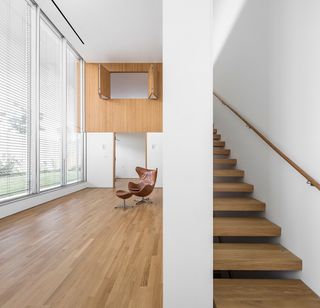
A typical interior, with a double-height reception space and vast windows.
Modularity was key to this massive site. The masterplan was changed, changed and changed again as the number of houses on the site shrank according to the market’s desires for larger properties. The architects initially offered eight individual housing designs, but interested buyers clearly preferred three, ranging in size from around 80 to 200 sq m.
Planned using a grid of 1.25m squares, the site combines private terrace spaces with a series of winding pathways and small plazas. From above, it’s a jigsaw of almost unthinkable complexity. ‘It’s like Tetris,’ Kogan jokes. ‘Each house is actually unique, although similar, because we came up with a system that allowed variations. There is also a unity of materials.’
‘Although it’s a bit industrial-looking,’ Glogowski adds, ‘we have made it intentionally scrambled – you don’t know where one house ends and another begins.’
Wallpaper* Newsletter
Receive our daily digest of inspiration, escapism and design stories from around the world direct to your inbox
Outside, brilliant white walls and wooden walkways and doors contrast with the cascades of planting. The latter was overseen by Isabel Duprat, a former friend and collaborator of the legendary Roberto Burle Marx, undertaking her first European commission. Beds of wild flowers, ground-hugging shrubs and mature trees are set among the asymmetrically arranged decking, which rises and falls over five levels.
It certainly fulfils the original MK27 brief of creating an instant village, something that appears to have emerged organically over time. However, beneath this tranquil, pedestrian-only realm – and making all the bucolic, ground-level splendour possible – is a rigorously designed concrete underworld, containing residents’ car-parking, basement space and direct, discreet access to the houses.
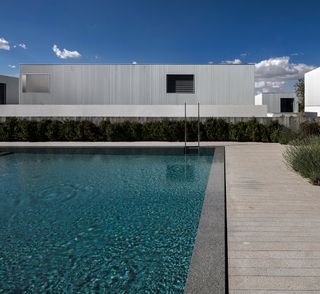
The communal swimming pool in the central square.
López wasn’t just the client, but also the executive architect and the contractor. ‘The quality of construction is absolutely high-end,’ says Kogan. ‘It’s rare to have a spec house of this quality.’
‘He was even more demanding than us,’ Simas recalls. Studio MK27 is working on other similar projects for Caledonian in Spain, as well as a spec office building. Shared design values have certainly helped the process in Somosaguas, where the community has been tight-knit from the outset, with a strong creative vibe among the new owners, which include other architects.
Kogan and Glogowski visited the site every few months throughout the two-year build, although most discussion was carried out over Skype. Glogowski explains that as well as responding to the changing unit size, the masterplan was also revised to accommodate personal requests by each household. ‘We did it many times,’ she recalls. ‘You change one window in one house and you have to change everything else.’
The end result is clearly worth the complexity. While the project has hints of the vernacular, or even contemporary Spanish modernism, it’s filtered through MK27’s distinctive South American approach to domestic space, with generous views of verdant landscapes and a mix of private and open spaces. Most importantly of all, these houses have created an instant neighbourhood, united by design.
‘Children especially love it – it’s like a small city,’ Glogowski says. The central ‘square’ has a communal swimming pool but the architects are quick to point out that this is not a gated community. ‘There are no exterior walls in this project,’ says Kogan. ‘The outside is defined by the shape of the houses, not walls.’ Public and private, personal and shared, the different spaces are clearly delineated to those in the know, yet the overall effect is a rich composition of life-enhancing forms.
As originally featured in the November 2017 issue of Wallpaper* (W*224)
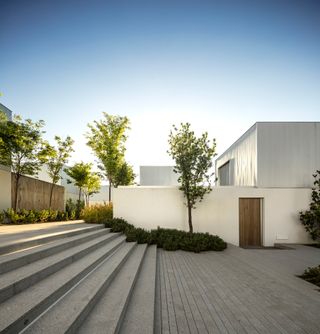
The landscaping creates multilevel spaces between the houses, with planting overssen by Isabel Duprat.
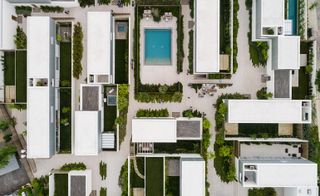
The jigsaw-like structure of the development reflects the architects’ desire to create an instant neighbourhood.

Each house is unique, however materials used across the development are consistent.

Parking access is located underground.
INFORMATION
For more information, visit the Studio MK27 website and the Caledonian website
Jonathan Bell has written for Wallpaper* magazine since 1999, covering everything from architecture and transport design to books, tech and graphic design. He is now the magazine’s Transport and Technology Editor. Jonathan has written and edited 15 books, including Concept Car Design, 21st Century House, and The New Modern House. He is also the host of Wallpaper’s first podcast.
-
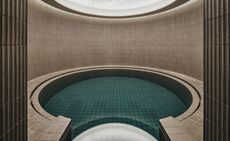 Find yourself at Six Senses Kyoto, the brand's breathtaking Japan debut
Find yourself at Six Senses Kyoto, the brand's breathtaking Japan debutSix Senses Kyoto opens its doors boasting tranquil, luxurious interiors by Blink Design Group
By Danielle Demetriou Published
-
 Shigeru Ban’s mini Paper Log House welcomed at The Glass House
Shigeru Ban’s mini Paper Log House welcomed at The Glass House'Shigeru Ban: The Paper Log House' is shown at The Glass House in New Canaan, USA as the house museum of American architect Philip Johnson plays host to the Japanese architect’s model temporary home concept
By Adrian Madlener Published
-
 Artist Mickalene Thomas wrestles with notions of Black beauty, female empowerment and love
Artist Mickalene Thomas wrestles with notions of Black beauty, female empowerment and love'Mickalene Thomas: All About Love’, a touring exhibition, considers Black female representation
By Hannah Silver Published
-
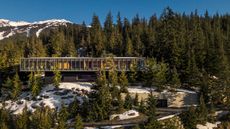 Marcio Kogan’s Studio MK27 celebrated in this new monograph from Rizzoli
Marcio Kogan’s Studio MK27 celebrated in this new monograph from Rizzoli‘The Architecture of Studio MK27. Lights, camera, action’ is a richly illustrated journey through the evolution of this famed Brazilian architecture studio
By Jonathan Bell Published
-
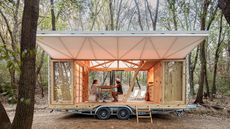 MOCA is a self-sufficient mobile home offering freedom to work (and roam)
MOCA is a self-sufficient mobile home offering freedom to work (and roam)MOCA (Mobile Catalyst) is a sustainable mobile home designed by the Institute for Advanced Architecture of Catalonia, and taking remote working to a new level
By Tianna Williams Published
-
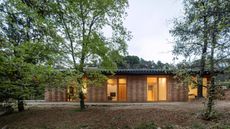 Low-energy house in Catalonia minimises its footprint to make the most of its site
Low-energy house in Catalonia minimises its footprint to make the most of its siteAlventosa Morell Arquitectes’ low-energy house in Catalonia nestles into the landscape
By Jonathan Bell Published
-
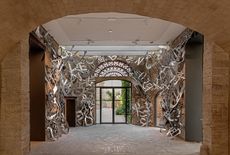 Hortensia Herrero Art Centre puts Valencia on the contemporary art map
Hortensia Herrero Art Centre puts Valencia on the contemporary art mapHortensia Herrero Art Centre launches in Valencia, offering a home for contemporary art to sit side by side with archaeological treasures
By Blaire Dessent Published
-
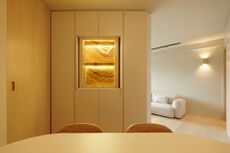 Collective, Hong Kong and Spain: Wallpaper* Architects Directory 2023
Collective, Hong Kong and Spain: Wallpaper* Architects Directory 2023With bases in Hong Kong and Spain, Collective joins the Wallpaper* Architects’ Directory 2023, our annual round-up of exciting emerging architecture studios
By Ellie Stathaki Published
-
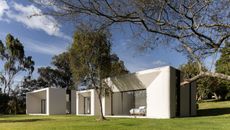 Nicolás y Nicolás, Spain and Ecuador: Wallpaper* Architects’ Directory 2023
Nicolás y Nicolás, Spain and Ecuador: Wallpaper* Architects’ Directory 2023With offices in Spain and Ecuador, Nicolás y Nicolás is part of the Wallpaper* Architects’ Directory 2023, our annual round-up of exciting emerging architecture studios
By Ellie Stathaki Published
-
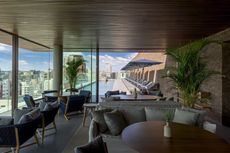 Fasano Itaim brings the hospitality brand full circle back to São Paulo
Fasano Itaim brings the hospitality brand full circle back to São PauloFasano Itaim is the luxury Brazilian hospitality brand’s second outpost in São Paulo – and it just opened with a design by Studio MK27
By Scott Mitchem Published
-
 This light-filled Spanish house is defined by openness and geometry
This light-filled Spanish house is defined by openness and geometryA Spanish house by Arquitecturia Camps Felip is designed around its courtyards and its six volumes’ bold geometry
By Ellie Stathaki Published